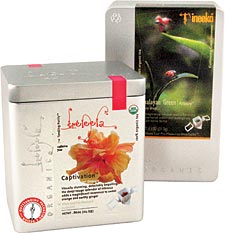This spring, a seventh Argo Tea location opens in the South Loop; by 2008, the company’s founders-Arsen Avakian, 31; Daniel Lindwasser, 49; and Simon Simonian, 31-aim to have expanded beyond Chicago. Chicago interviewed Avakian, who explained that the name Argo references the trio’s Mediterranean heritage as well as the mythological hero Jason and his Argonauts: “Like Jason, we want to help American customers discover a new world of tea.”
by Ceil Miller Bouchet
Q: When you opened the first Argo in 2003, did you know that the loose-leaf tea trend was on the rise?
A: We knew that specialty loose-leaf tea was one of the fastest-growing segments in the beverage industry. But we were more interested in taking a Starbucks-like model and applying it to tea.
Q: Argo does seem more similar to Starbucks than a Victorian teashop.
A: We serve over 20,000 customers per week. That means our operational flow has to be set up to serve quickly and consistently. For example, we brew tea concentrates up daily in vats at the Randolph Street store and send them to other locations, where they’re then diluted on a drink-by-drink basis.
Q: What did you learn by starting your own business?
A: We were creating a new market segment. It took more time than we thought to build a solid team, form a crisp and sharp brand name, put the technology in place to ensure consistent quality, nurture good relationships with suppliers. We decided we wouldn’t take short cuts with any of these things. So we take it slow and only open a new branch once the previous one is profitable.
Q: What about social responsibility in procurement? Most tea comes from really poor regions of the world.
A: We’ve taken the time to develop individual relationships with our suppliers, who are mostly specialty plantations in Asia. And we have an intimate knowledge and control of where the tea’s coming from and how it’s transported. Unfortunately, the social and economic conditions of many Asian countries aren’t conducive to fair trade practices. But there is a movement, even among large tea companies like Lipton, toward more of a fair trade mentality. We support fair trade. But it’s difficult to implement, being a smaller company.
Q: I recently tried one of your signature drinks: the hibiscus steamer. It tasted like a Snapple. Do you see any danger in promoting a sweetened drink as healthy?
A: Our beverages are 100 percent natural. We use only unprocessed natural sugar cane juice as a sweetener. It’s not the sweetener that’s unhealthy; sugar’s fine if consumed in moderate quantities.
Q: But hibiscus isn’t really tea.
A: Hibiscus tea is what we call herbal tea, which means that it doesn’t come from the tea bush called Camellia sinensis. But hibiscus is high in vitamin C and, as an herbal drink, blends well with apple cider. The hibiscus steamer is one of our most popular drinks.
A Wine Snob’s Guide to Fine Tea
Tea expert Shashank Goel believes artisanal tea has a lot in common with fine wine. He should know; the India-born Goel owns a 12,000-acre tea estate in the Himalayas. Two years ago, with his wife, Sumita, he launched his own fine tea brand, Ineeka, out of a warehouse in Chicago’s Kinzie industrial corridor. Chicago asked Goel, who commands up to $2,000 per kilo for his specialty Darjeeling at Mariage Frères in Paris (a more affordable Ineeka variety sells at Whole Foods and Wild Oats for $10 a tin), for five ways wine lovers can approach tea.
Photograph: Megan Lovejoy
 STEER CLEAR OF ADDED FLAVOR “Let’s say you have a wine bottle and you have not uncorked it. Can you smell the wine? No. Any tea that smells in the dry form is a horrible tea. As soon as fine tea is brewed, you get this beautiful aroma from the infusion in the leaves. If it smells in the dry form, the smell comes from added flavor. They are taking a low-quality product and masking it with flavor.”
STEER CLEAR OF ADDED FLAVOR “Let’s say you have a wine bottle and you have not uncorked it. Can you smell the wine? No. Any tea that smells in the dry form is a horrible tea. As soon as fine tea is brewed, you get this beautiful aroma from the infusion in the leaves. If it smells in the dry form, the smell comes from added flavor. They are taking a low-quality product and masking it with flavor.”
GEOGRAPHY MATTERS “Wine comes from a few different types of grape. It is where the wine grows-for an example, in Champagne: that region gives it a certain characteristic. The Darjeeling region is to tea what Champagne is to wine. The Assam region is like Bordeaux.”
AIR IT OUT “Good tea should be steeped four or five minutes; if it is whole leaf tea, even if you steep it longer, it will get stronger and not bitter. [As for reusing the bag] I’m a purist. Would you dilute wine with water? No.”
TEA TASTING IS LIKE A WINETASTING “You look at the dry leaf, you smell the infusion, you taste. You even look at color. Good tea is supposed to have a nice bright color; even black tea should have a golden dark hue and look alive to you.”
TEA AND WINE SHARE THE SAME VOCABULARY “Green tea should be a mellow dry flowery finish. Intense for black teas. White teas generally are extremely, extremely light. It has got a very subtle perfumy taste, a light taste that lingers on. Just like a wine, if you have a great tea, it lingers on.”


